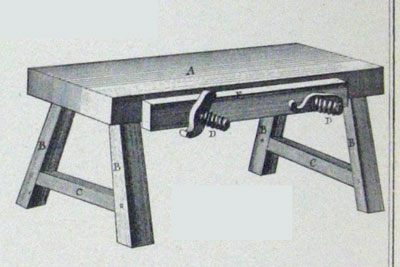A couple of months ago, I asked a number of colleagues what they considered the five most essential bookbinding tools. But nobody — myself included — mentioned what I now think the most essential tool for any craft is. Ok, it may not *technically* be a tool, but it is fundamental to most crafts.
Many animals use tools like this, for example the chipmunk that used the wood stairs below to break open an acorn. The tool or piece of equipment? A workbench.

Workbenches are important to book conservators, both practically and conceptually. A wobbly or insubstantial bench makes the most common activities much more difficult. The term serves as a shorthand for how one was trained: bench trained, apprentice trained, program trained. Every book conservation lab I’ve seen has a dedicated bench space for all full time technicians and conservators. Bench time is often specified as a percentage of work time distinct from other duties in job descriptions, though I’m always interested to hear from colleagues how accurate this turns out to be!
Why are workbenches are called benches. Aren’t they really worktables?
It turns out not to be a big mystery. Scott Landis, in his wonderful out-of-print book The Workbench Book, traces the workbench to an Egyptian carpenter’s bench from ca. 1475 B.C.E. And guess what, early workbenches look very much like a modern bench, not a table.

Landis describes a Roman bench ca. 250 B.C.E. that looks pretty much the same: a solid wood surface (about 2.75 x 14.5 x 102 inches, four splayed wooden legs, mortised into the top. Both appear roughly knee height. In other words, a bench.
Very similar workbenches continue until the 18th century for many trades, with subtle variations. Woodworking benches often had mortices for bench dogs or vices attached.
Bookbinders are often portrayed working at one of the three fundamental tools of the trade: a lying or cutting press, a sewing frame, or a standing press. In the second quarter of the 19th century, the shift to case binding as the predominate structure likely created a need for a more table like work surface. Many trades have different names for similar tools. For example, what most trades call a “tommy bar” bookbinders call a “press pin”. But the term workbench may have been borrowed from other trades.

Joel Moskowitz of Tools for Working Wood had a fun quiz on his blog a couple of years ago, trying to match seven workbenches found in Diderot to the trade associated with them. Although the prize is long gone, it is still quite fun to imagine how each bench may was used. And as he mentions, no cheating by looking it up!
